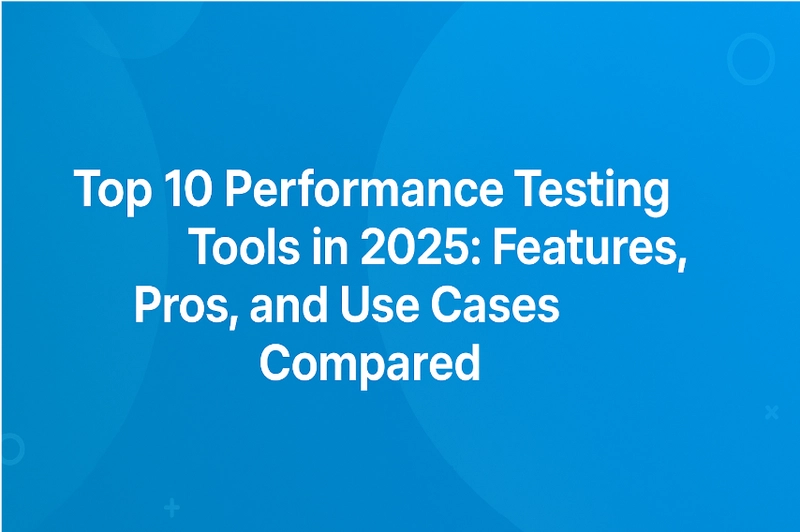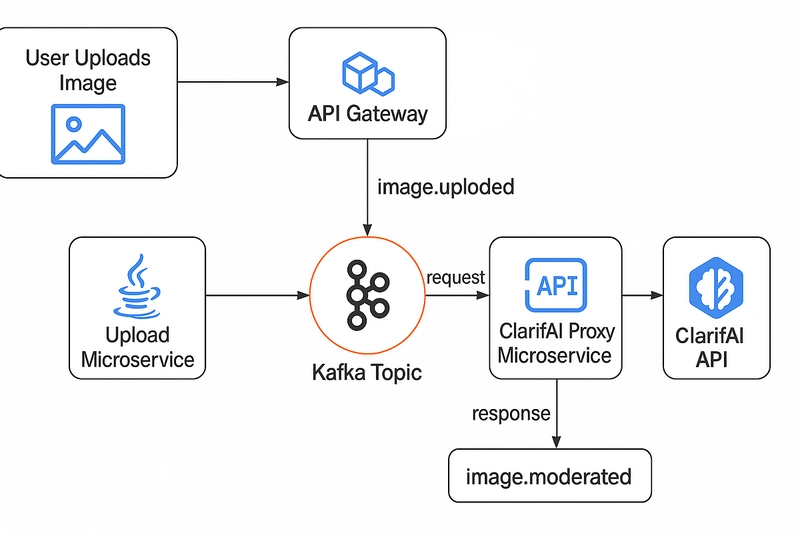Top 10 Performance Testing Tools in 2025: Features, Pros, and Use Cases Compared
In 2025, performance testing continues to play a crucial role in ensuring that software applications deliver optimal speed, scalability, and stability under expected workloads. With increasing demand for responsive and high-performing applications, businesses are looking to adopt the best tools in the market. This article explores the top 15 performance testing tools in 2025, providing insights into their key features, pros, and ideal use cases. But first, let’s understand what is performance testing and why it matters. Performance Testing Performance testing is a type of non-functional testing that evaluates how a software application performs under various conditions. It measures metrics like response time, throughput, reliability, scalability, and resource usage. The goal is to ensure the system meets the performance criteria defined in the requirement documents. Performance testing in software testing helps identify bottlenecks, verify the robustness of systems, and ensure customer satisfaction. It typically precedes production deployment and is essential for mission-critical applications. Types of Performance Testing There are several types of performance testing, each with distinct objectives: Load Testing: Measures how the system performs under expected user loads. Stress Testing: Determines the system's robustness under extreme or unexpected loads. Spike Testing: Checks performance during sudden increases in load. Endurance Testing: Evaluates how the system behaves under a significant load over an extended time. Scalability Testing: Assesses the application's ability to scale up with increased demand. Understanding the difference between load testing and performance testing is essential. While load testing is a subset of performance testing focused on expected usage, performance testing encompasses broader evaluations under various scenarios. Now that we’ve clarified the basics, let’s dive into the list of performance testing tools dominating 2025. 1. TestGrid TestGrid is an AI-powered testing platform that supports web, mobile, and API testing across 1000+ real Android and iOS devices. It offers visual testing, real device cloud, and a record-and-playback system to streamline test automation. The platform integrates easily with CI/CD tools and offers advanced debugging with real-time alerts and in-depth logs. A standout feature is CoTester, an AI agent trained on testing frameworks like Selenium, Appium, and more, which understands intent and generates precise test cases. TestGrid simulates real-world conditions like low battery, weak network, and touch gestures—giving full visibility into your app's behavior post-deployment. 2. K6 k6 is a modern load testing tool built for developers, using JavaScript for scripting performance tests. It excels in testing APIs, microservices, and backend systems during early development stages. The CLI-based tool supports seamless CI/CD integration, allowing teams to automate tests in agile workflows. k6 also supports browser-level testing via xk6-browser and provides powerful visualizations when paired with Grafana for monitoring. Its lightweight design makes it suitable for both local testing and distributed testing at scale. 3. Gatling Gatling offers high-performance load testing with a focus on backend scalability. Built on Scala, it simulates massive traffic loads while tracking metrics like latency, response time, and throughput. Its clean HTML reports and real-time feedback help teams diagnose bottlenecks effectively. You can run tests locally or via Gatling Enterprise in the cloud for distributed execution. Gatling also supports API testing and integrates easily into Jenkins and other CI workflows. 4. Locust Locust is a Python-based open-source performance testing tool known for its flexibility and scalability. You can define user behavior using Python scripts and simulate millions of concurrent users. It’s highly useful for distributed testing across multiple machines and environments. Locust provides a web-based UI for test control and real-time results during execution. Pairing it with browser automation tools enables UI and end-to-end performance testing across your stack. 5. Apache JMeter Apache JMeter is a staple in performance testing, known for its support of multiple protocols—HTTP, JDBC, FTP, and more. It’s Java-based and platform-independent, with a GUI for building complex test plans without much code. JMeter is ideal for both beginners and advanced testers, thanks to its plugin-rich ecosystem. It supports load testing, distributed testing, and integrates with tools like Jenkins and BlazeMeter for scalable execution. 6. BlazeMeter BlazeMeter is a cloud-based performance testing tool that builds on JMeter while adding enterprise-grade features. It enables testing at scale with thousands of virtual users and global distribution. The platform

In 2025, performance testing continues to play a crucial role in ensuring that software applications deliver optimal speed, scalability, and stability under expected workloads. With increasing demand for responsive and high-performing applications, businesses are looking to adopt the best tools in the market. This article explores the top 15 performance testing tools in 2025, providing insights into their key features, pros, and ideal use cases. But first, let’s understand what is performance testing and why it matters.
Performance Testing
Performance testing is a type of non-functional testing that evaluates how a software application performs under various conditions. It measures metrics like response time, throughput, reliability, scalability, and resource usage. The goal is to ensure the system meets the performance criteria defined in the requirement documents.
Performance testing in software testing helps identify bottlenecks, verify the robustness of systems, and ensure customer satisfaction. It typically precedes production deployment and is essential for mission-critical applications.
Types of Performance Testing
There are several types of performance testing, each with distinct objectives:
- Load Testing: Measures how the system performs under expected user loads.
- Stress Testing: Determines the system's robustness under extreme or unexpected loads.
- Spike Testing: Checks performance during sudden increases in load.
- Endurance Testing: Evaluates how the system behaves under a significant load over an extended time.
- Scalability Testing: Assesses the application's ability to scale up with increased demand.
Understanding the difference between load testing and performance testing is essential. While load testing is a subset of performance testing focused on expected usage, performance testing encompasses broader evaluations under various scenarios.
Now that we’ve clarified the basics, let’s dive into the list of performance testing tools dominating 2025.
1. TestGrid
TestGrid is an AI-powered testing platform that supports web, mobile, and API testing across 1000+ real Android and iOS devices. It offers visual testing, real device cloud, and a record-and-playback system to streamline test automation.
The platform integrates easily with CI/CD tools and offers advanced debugging with real-time alerts and in-depth logs. A standout feature is CoTester, an AI agent trained on testing frameworks like Selenium, Appium, and more, which understands intent and generates precise test cases. TestGrid simulates real-world conditions like low battery, weak network, and touch gestures—giving full visibility into your app's behavior post-deployment.
2. K6
k6 is a modern load testing tool built for developers, using JavaScript for scripting performance tests. It excels in testing APIs, microservices, and backend systems during early development stages. The CLI-based tool supports seamless CI/CD integration, allowing teams to automate tests in agile workflows. k6 also supports browser-level testing via xk6-browser and provides powerful visualizations when paired with Grafana for monitoring. Its lightweight design makes it suitable for both local testing and distributed testing at scale.
3. Gatling
Gatling offers high-performance load testing with a focus on backend scalability. Built on Scala, it simulates massive traffic loads while tracking metrics like latency, response time, and throughput. Its clean HTML reports and real-time feedback help teams diagnose bottlenecks effectively. You can run tests locally or via Gatling Enterprise in the cloud for distributed execution. Gatling also supports API testing and integrates easily into Jenkins and other CI workflows.
4. Locust
Locust is a Python-based open-source performance testing tool known for its flexibility and scalability. You can define user behavior using Python scripts and simulate millions of concurrent users. It’s highly useful for distributed testing across multiple machines and environments. Locust provides a web-based UI for test control and real-time results during execution. Pairing it with browser automation tools enables UI and end-to-end performance testing across your stack.
5. Apache JMeter
Apache JMeter is a staple in performance testing, known for its support of multiple protocols—HTTP, JDBC, FTP, and more. It’s Java-based and platform-independent, with a GUI for building complex test plans without much code. JMeter is ideal for both beginners and advanced testers, thanks to its plugin-rich ecosystem. It supports load testing, distributed testing, and integrates with tools like Jenkins and BlazeMeter for scalable execution.
6. BlazeMeter
BlazeMeter is a cloud-based performance testing tool that builds on JMeter while adding enterprise-grade features. It enables testing at scale with thousands of virtual users and global distribution. The platform supports functional, load, and API tests, plus real-time reporting dashboards. BlazeMeter offers scriptless test creation, CI/CD integrations, and APM support for complete visibility. It's also great for testing mobile apps, web apps, and microservices in dynamic cloud environments.
7. Tricentis NeoLoad
Tricentis NeoLoad is built for enterprise performance testing of web, mobile, and packaged applications. It simulates thousands of users and helps ensure responsive UX under load. NeoLoad features real-time monitoring, cloud-based test execution, and visual test design.
Its scriptless design makes it accessible to non-developers while still offering power for engineers. With strong CI/CD and DevOps toolchain integration, NeoLoad is ideal for continuous performance testing at scale.
8. Taurus
Taurus is a performance test automation framework that acts as a wrapper for tools like JMeter, Gatling, and Locust. Tests are written in easy-to-read YAML, reducing complexity for teams.
It’s great for integrating automated performance testing into CI/CD pipelines without switching tools. Taurus supports browser-based tests via Selenium and combines functional and performance testing in one flow. You also get command-line control, reporting, and compatibility with dashboards like Grafana.
9. Silk Performer
Silk Performer by Micro Focus supports large-scale load testing for web, mobile, and enterprise apps. It simulates high traffic volumes to uncover performance issues before release.
The tool includes robust analytics and built-in cloud support for distributed testing.
Silk Performer supports protocols like HTTP, SAP, Oracle, and Citrix—making it ideal for complex enterprise systems. It integrates with monitoring and CI/CD tools to ensure smooth DevOps performance workflows.
10. Test Modeller
Test Modeller streamlines performance test creation using a visual, drag-and-drop modeling interface. It supports test automation, cloud execution, and real-time dashboards.
With dynamic data-driven testing and reusable scenarios, it reduces test maintenance overhead. Its collaborative features—version control, shared spaces, and feedback tools—boost team productivity. You can integrate it with Jenkins, Azure DevOps, and tools like Sauce Labs for continuous performance validation.
How to Do Performance Testing
How to do performance testing effectively involves several key steps:
Requirement Gathering: Define performance criteria and objectives.
- Test Planning: Choose the appropriate performance testing tools and design test cases.
- Environment Setup: Mimic production conditions as closely as possible.
- Test Execution: Run various types of performance testing scenarios.
- Monitoring & Analysis: Use dashboards and logs to identify bottlenecks.
- Tuning & Retesting: Optimize code or infrastructure and rerun tests.
Choosing the Right Tool
The best tool depends on your team’s skill set, the tech stack in use, and the type of application being tested. For example, developers may prefer Locust or K6 due to their scripting flexibility, while enterprise QA teams might lean towards LoadRunner or NeoLoad for their robustness.
In 2025, the list of performance testing tools offers something for everyone—whether you're testing a startup's web app or a Fortune 500's multi-region cloud system.
Final Thoughts
With the increasing complexity of modern applications, using the right tools for performance testing in software testing is more important than ever. The list of performance testing tools mentioned above caters to a wide range of use cases, from web and mobile apps to microservices and containerized deployments. Whether your priority is ease of use, scalability, or integration with CI/CD, there’s a tool out there to meet your needs.
By understanding what is performance testing, the types of performance testing, and how to align them with your goals, teams can build faster, more reliable software. Keep this list of performance testing tools handy as you plan your next testing strategy—and leverage performance test automation to stay competitive in 2025 and beyond.





































































![M4 MacBook Air Drops to New All-Time Low of $912 [Deal]](https://www.iclarified.com/images/news/97108/97108/97108-640.jpg)
![New iPhone 17 Dummy Models Surface in Black and White [Images]](https://www.iclarified.com/images/news/97106/97106/97106-640.jpg)










































































































_Olekcii_Mach_Alamy.jpg?width=1280&auto=webp&quality=80&disable=upscale#)























































































![[The AI Show Episode 144]: ChatGPT’s New Memory, Shopify CEO’s Leaked “AI First” Memo, Google Cloud Next Releases, o3 and o4-mini Coming Soon & Llama 4’s Rocky Launch](https://www.marketingaiinstitute.com/hubfs/ep%20144%20cover.png)










































































































































![[DEALS] Sterling Stock Picker: Lifetime Subscription (85% off) & Other Deals Up To 98% Off – Offers End Soon!](https://www.javacodegeeks.com/wp-content/uploads/2012/12/jcg-logo.jpg)































































































